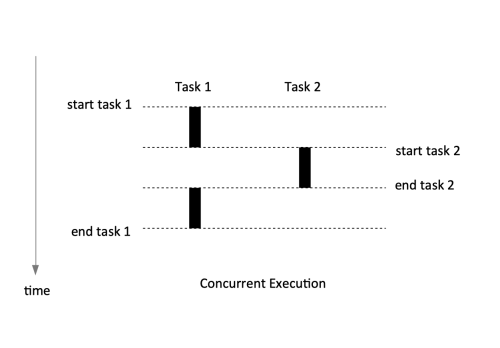Concurrent (Parallel) Programming: Difference between revisions
| Line 16: | Line 16: | ||
* [[Go Language Concurrency]] | * [[Go Language Concurrency]] | ||
* [[Python Threads and Concurrency]] | * [[Python Threads and Concurrency]] | ||
=Parallel vs. Concurrent= | =Parallel vs. Concurrent= | ||
Revision as of 21:38, 31 August 2023
Internal
Overview
Concurrency and parallelism refer to slightly different things, but we discuss about "concurrent (parallel)" programming just because we want "concurrent" and "parallel" search to hit the same article.
Concurrent programming (or concurrency) is the management of multiple tasks that exist, and possibly execute, at the same time. Concurrent programming includes management of task execution, communication between tasks and synchronization between tasks.
Explicitly addressing concurrency issues is software is becoming more important as Moore Law does not hold anymore. For a while, the number of transistors on the chip doubled every two years. That brought smaller transistor size, and less power consumption. Smaller transistors switch faster. As density increases, you get natural speedup. Exponential increase in density brought exponential increase in speed. However, this scaling down came with a power and temperature problem. The dynamic power consumption P is given by α * C * F * V2, where α is the percentage of time switching, C is capacitance (goes down as the transistor shrinks), F is clock frequency and V is voltage differential. With smaller transistors, C and V are smaller. The fact that the voltage scales with transistor size is called Dennard Scaling. The natural consequence is that for the same dynamic power, the frequency can go higher. However, transistors cannot get smaller under a certain threshold: noise, power leakage, etc, so the frequency cannot get higher. If the frequency goes higher, the power consumption will go beyond the capacity of the chip to dissipate power, and it will melt. This problem is known as the "power wall". The second factor that works against increasing the frequency as a source of overall speedup of the system is the Von Neumann bottleneck: the main memory access is orders of magnitude slower than the processor, so even if the processor is fast, it'll idle waiting for memory access. People work around this by onboarding fast caches on processors.
The hardware design works around the incapacity to scale down transistors anymore by packing more cores on the chip. A core is essentially sequential, so in order to use the system effectively, concurrent programming is necessary.Parallel execution is needed to exploit multi-core systems. There is research going on into parallel compilers, that attempt to automatically parallelize a program, but that is not going very well. It is still the programmer's job to decompose the task so it renders itself to parallel execution.
Implementations in programming languages:
Parallel vs. Concurrent
"Concurrent execution" of two tasks means that the tasks execution overlaps. Concurrency can be achieved with serial hardware, such as a processor that executes one instructions at the time. It can be of course achieved on replicated hardware too.
"Parallel execution" means executing two tasks at the same time. Parallelism is only achievable with replicated hardware, usually a multi-core processor. Determining which hardware performs which task is called hardware mapping. Usually this is not controlled by the programmer.
The completion time for concurrent execution is longer than parallel execution.
In concurrent programming, usually the programmer determines which tasks can be executed in parallel, communication between tasks, synchronization between tasks, etc. Usually the programmer does not decide which tasks will be perform in parallel and they they don's specify hardware mapping. That is left to the O/S and the programming language runtime scheduler.
Concurrency improves performance even without parallelism. This is because tasks usually wait for some event (over network, for example) and concurrent programming helps to preempt that task and use the processor for other tasks that are ready for compute. Concurrency can help to "hide latency".
Synchronization
A way to address concurrent updates of shared state in concurrent programming is to use locks. Locks are problematic because they rely of the capacity of the programer to identify problem areas that require concurrent access protection. As the complexity of the program increases, the reliance of this capacity may become problematic.
An alternative approach is to use an actor model.

